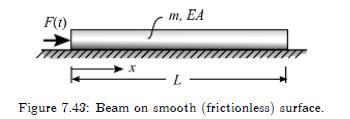An unrestrained beam lies on a horizontal and smooth surface and at (t=0) is forced at one
Question:
An unrestrained beam lies on a horizontal and smooth surface and at \(t=0\) is forced at one end by \(F(t)\), as shown in Figure 7.43. Derive the general response for any forcing function using the known eigenvalues and eigenfunctions. Then evaluate the specific steady-state response for the following specific forcing functions:
(a) \(F(t)=F_{0} u(t)\), where \(u(t)\) is the unit step function
(b) \(F(t)=\sin \Omega t\), for the case where \(\Omega=\omega_{n} / 2\)
(c) \(F(t)=1-t / t_{0}, 0 \leq t \leq t_{0}\)
(d) \(F(t)=\delta(t)\), where \(\delta(t)\) is the Dirac delta function.

Fantastic news! We've Found the answer you've been seeking!
Step by Step Answer:
Related Book For 

Mechanical Vibration Analysis, Uncertainties, And Control
ISBN: 9781498753012
4th Edition
Authors: Haym Benaroya, Mark L Nagurka, Seon Mi Han
Question Posted:





